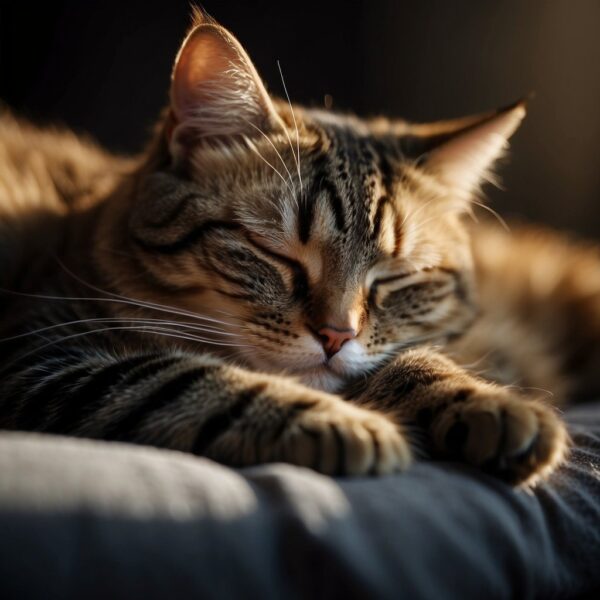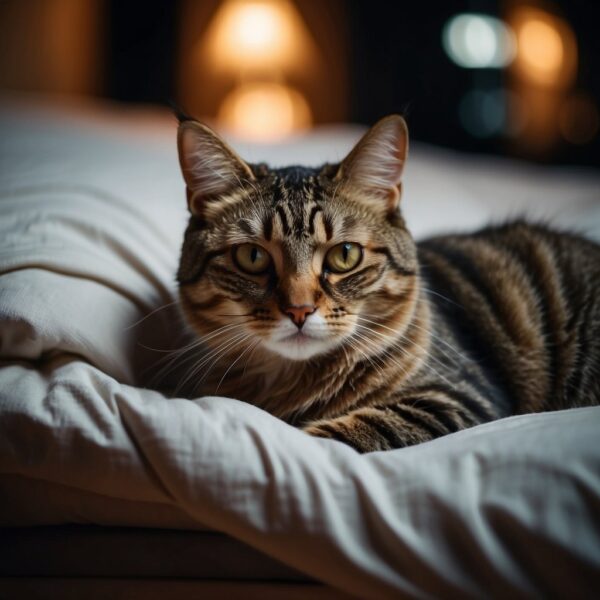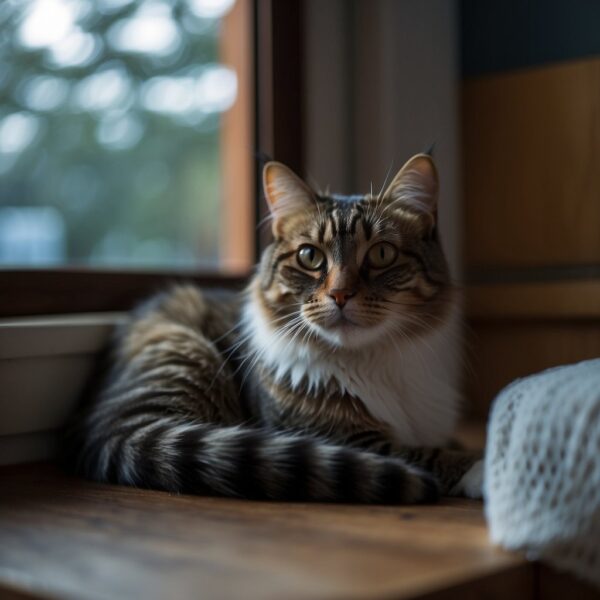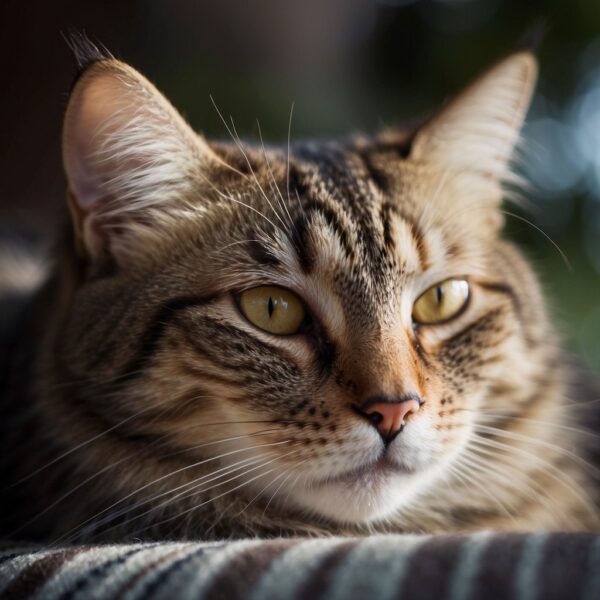
Cats Sleeping with Eyes Open: Cat Sleep Behavior
Cats are known for their unique sleeping habits, and one curiosity that often intrigues their guardians is the tendency of some cats to sleep with one eye open. This behavior is not uncommon among felines and has practical explanations rooted in their physiology and environmental adaptations. Primarily, it serves as a survival tactic providing them with the security of being able to rest while remaining alert to potential dangers nearby. Additionally, the anatomical structure of their eyes supports this ability, as cats possess a third eyelid known as the nictitating membrane, which can protect the eye and keep it moist while allowing them to stay partially aware of their surroundings.
Understanding why cats sleep this way requires a deeper look into their sleep cycles. Cats experience both non-REM and REM (rapid eye movement) stages of sleep. During the non-REM phase, they can wake easily, which is when they are most likely to sleep with their eyes partially open. As sleep becomes deeper and transitions into the REM phase, it’s more common for their eyes to close completely. However, some cats may still keep their eyes slightly open due to the extreme relaxation of muscles during this stage. Observing a cat’s sleeping habits, including their eyes’ positions, can provide insights into their health and well-being as deviations from their normal behavior might be indicators of discomfort or injury.
Key Takeaways for why cats sleep with one eye open
- Some cats sleep with one eye open as a survival behavior to remain alert.
- The presence of a third eyelid allows them to protect their eyes while keeping them partially open.
- Observing changes in a cat’s sleeping eye behavior can indicate health issues.
Understanding Cats Sleeping with eyes open
Cat sleep behavior is a complex blend of instinctual habits and biological needs, involving varied sleep phases and patterns influenced by diet, age, and daily activities.
Sleep Cycle in Cats
Cats experience two main sleep states: REM (rapid eye movement) sleep and non-REM sleep. During REM sleep, cats may exhibit twitching movements indicative of dreaming, whereas non-REM sleep is a more tranquil phase.
Different Phases of Cat Sleep
Non-REM sleep is a deep sleep state that allows for complete rest, while the REM stage is characterized by light sleep, where cats often display rapid eye movements and may react to their dreams.
The Science of Cat Napping
Cats are notorious for taking short, frequent naps throughout the day, conserving energy for bursts of intense activity. This enables them to remain alert to potential dangers or sudden opportunities to hunt.
Cat Sleep vs. Dog Sleep
Comparatively, cats tend to sleep more than dogs, with feline sleep patterns influenced by their natural, nocturnal hunting instincts, while dogs often adapt to their guardian’s routine.
How Diet Influences Sleep Patterns
The type and timing of meals can affect a cat’s sleep. A healthy diet providing the right nutrition can promote regular sleep patterns, whereas a poor diet can lead to restlessness.
Potential Causes of Sleep Disruption
Noisy environments, changes in routine, or health issues could disturb a cat’s sleep. A visit to the vet can ascertain if there’s an underlying medical cause for disrupted sleep.
Evolution of Sleep Behavior
Evolution has shaped cat sleep behavior as a survival mechanism, balancing rest with the readiness to react to danger. Their survival instinct mandates they remain on alert even during sleep.
Common Sleeping Positions
Felines adopt various sleeping positions, from curled up with paws tucked in, to stretched out on their backs. These positions reflect their level of comfort and security in their environment.
Age-Related Sleep Changes
Kittens and older cats often require more sleep. As felines age, they may experience changes in sleep duration and quality, corresponding with their shifting energy levels.
Impact of Play and Activity on Sleep
Daily play and activity levels influence feline sleep patterns. Engaging in shenanigans and playtime helps to expend energy, leading to deeper, more restorative rest periods.
Sleep and Feline Well-Being
Adequate sleep is vital for a cat’s health and well-being. Regular sleep patterns help maintain their mental sharpness and physical health, making it important to provide a serene sleeping environment.
Research on Feline Sleep
Researchers and veterinarians are continuously studying feline sleep to better understand its impact on behavior and health, offering insights into the importance of sleep for a cat’s overall well-being.
Interpreting Cat Sleep Patterns
Observing and interpreting sleep patterns can inform parents about their cat’s health and environment. Consistent behavior typically indicates contentment, while erratic sleeping can be a sign of stress or illness.

Reasons Cats Sleep with Eyes Partially Open
When observing feline behavior, one interesting aspect is their tendency for cats to sleep with their eyes open or partially open. This behavior can be attributed to various factors, from natural instincts to health concerns.
cats sleep with one eye open: Protection Mechanism
Cats retain many characteristics from their wild ancestors, including the survival instinct to remain alert to potential predators or danger even while resting. Having their eyes open or partially open allows them to quickly wake and respond to any threats, which is essential for their survival.
Cat Sleeping with Eye Open is a Sign of Light Sleep Phases
During the lighter phases of sleep, cats often display unique sleep patterns where their eyes may be partially open. These phases, such as light sleep or non-REM sleep, enable the cat to rest while still being semi-alert to their surroundings, and ready to spring into action if necessary.
Health and Medical Reasons
While often a benign behavior, sleeping with open eyes can occasionally indicate a health issue. Signs of pain, injury, or other medical problems should be assessed by a vet. Consistent sleeping with eyes open accompanied by other symptoms could warrant a medical evaluation.
The Third Eyelid
Cats have a third eyelid, also known as the nictitating or nictating membrane. This translucent eyelid can close while the primary eyelids remain open, offering protection and moisture to the eye without obstructing vision.
Natural Instincts and Sleep Behavior
Cats’ natural instincts influence their sleep behavior. In the wild, staying partially alert during rest is a tactic for survival. This is why domestic cats might still hide and seek secluded, secure locations for sleep, keeping their eyes at least partially open as an instinctual defensive action.
Environmental Influences
Finally, the environment can impact a cat’s tendency to sleep with their eyes open. A noisy environment or one where the cat does not feel fully at ease might lead to this behavior as a way to quickly take in their surroundings and prepare to hide or escape if disturbed.

Physical and Health Indicators in Cat Sleep
In observing a cat’s sleep, certain physical behaviors and health indicators provide insights into their well-being. These indicators can range from normal sleep patterns to signs that may warrant a veterinary visit.
Evaluating Sleep Health
Cats typically sleep for 12-16 hours a day, which is essential for their normal physiology and behavior. It’s important to note that while sleeping, a healthy cat’s eyelids may partially or fully close; however, a translucent third eyelid may still be visible. This does not necessarily indicate a problem, but rather is a feature of the cat’s unique anatomy.
Role of Rapid Eye Movement
During REM sleep, a cat may exhibit quick movements of the eyes behind closed or partially closed lids, which is a normal behavior indicating they are in a deep sleep phase, often associated with dreaming. This stage of sleep is crucial for maintaining healthy brain function.
Monitoring for Pain and Discomfort
Observing a cat’s sleep position and behavior can help detect signs of pain or discomfort. If a cat is sleeping with an unusual posture, continuously adjusting its position, or showing reluctance to lie down, it may indicate an underlying health issue.
Signs of Illness in Sleep Behavior
Changes in sleep habits, such as a noticeable increase or decrease in sleep duration, or restlessness, can be symptoms of illness. Additionally, behaviors like excessive vocalization or agitation during sleep could be symptoms alerting to a potential health concern.
When to Seek Veterinary Attention
Guardians should consult with a veterinarian if there are persistent changes in sleep patterns, if the cat exhibits signs of pain, or if there is any injury to the eyes or body. These could signify health issues that may require medical intervention.
Understanding Normal Sleep Twitching
It is common to see cats twitch during sleep; this usually involves subtle movements of the paws, tail, or whiskers. This twitching is normal and should not be cause for concern unless it is excessively violent or accompanied by other distress signals.
Anatomical Features in Cat Sleep
In examining feline sleep, it is important to focus on specific anatomical features that influence why cats might sleep with their eyes partially open. These include the role of the eyelids, the unique nictitating membrane, and the control of muscles during sleep.
The Role of the Eyelids
Cats’ eyelids function similarly to human eyelids, providing protection for the eyes by shielding them from debris and drying out. When a cat blinks, it spreads tears across the surface of the eye to keep it from watering or suffering from dry eyes. The ability of cats to sleep with their eyes partially open might lead to reduced blinking and necessitate the protective role of the nictitating membrane.
Understanding the Nictitating Membrane
The nictitating membrane, commonly known as the third eyelid, is a translucent feature unique to feline vision that provides an additional layer of protection. It can sweep across the eye to remove debris or lubricate the cornea, which is especially beneficial if the primary eyelids remain partially open during sleep. This third eyelid is crucial for maintaining eye health and can help prevent disease and dry eye.
Muscle Control and Sleep Positions
During different sleep stages, specifically REM (rapid eye movement) sleep, cats exhibit relaxed muscle control which affects their sleeping positions. A cat may rest with its paws or feet positioned in such a way that leads to the eyes being partially open. It’s not uncommon to observe a cat’s eyes rolling back or twitching during REM sleep due to the loss of muscle function, leading its eyes to remain open unconsciously. This state of relaxation should not be a cause for concern unless it is coupled with signs of a health issue.

Behavioral Aspects of Cat Sleep
Cats possess unique sleep behaviors and patterns that are deeply ingrained in their physiology and daily routines.
Daily Habits and Sleep Rhythms
Cats typically experience sleep in several shorter periods throughout the day rather than the long, uninterrupted slumbers that humans do. Known for their crepuscular nature, which means they are most active during the twilight hours of dawn and dusk, their sleep schedule revolves around these peaks of activity. A cat’s daily routine intersperses napping with various activities like playtime, hunting for meals, and engaging in typical shenanigans such as jumping or scratching. These bursts of energy expenditure are followed by restful recuperation in the form of sleep.
- Sleep Duration:
- Younger cats and kittens may sleep up to 20 hours per day
- Adult cats average around 12-16 hours per day
- Activity-Sleep Balance:
- Active period: Dawn/dusk
- Rest period: Scheduled napping post mealtime or play
Why Cats Sleep with Eyes Open Conclusion
Cats often sleep with their eyes partially open due to instinctual behaviors tied to their survival. This trait allows them to remain alert to environmental changes even while resting, providing an advantage in detecting potential threats.
Health-wise, if a cat exhibits this behavior without signs of distress or discomfort, it is typically considered normal. Parents should observe for any indicators of eye injuries, such as discharge, redness, or cloudiness, which necessitate a veterinary assessment.
For the well-being of a cat, understanding and accepting this sleeping pattern is important. Interfering, such as attempting to close a cat’s eyes during sleep, is unnecessary. Ensuring a safe and tranquil sleeping environment can contribute to better rest, whether a cat chooses to sleep with eyes open or closed.
In summary, the behaviors exhibited during cat sleep, including eye openness, fall within a range of normal feline activities. These traits underscore the complex and well-adapted nature of cats to their surroundings, often reflective of a healthy state of alertness even during periods of vulnerability.
Observations to Consider:
- Normal Behavior: Partially open eyes during sleep.
- Health Indicators: Clear eyes without discharge or injury.
- Parent Actions: No intervention required; monitor for changes.
Acknowledging the uniqueness of feline sleep patterns enriches the understanding and bond between cats and their guardians. It is a testament to the evolutionary adaptations of these beloved pets.

Cats Sleeping with Eyes Open Frequently Asked Questions
Sleeping behaviors in cats, including eye positioning, are often curious to cat parents. This section addresses common queries relating to why some cats sleep with their eyes open and associated behaviors that might indicate health or comfort levels.
What could indicate sickness in a cat’s sleeping behavior?
If a cat exhibits significant changes in its sleeping patterns, such as excessive sleepiness, restlessness, or vocalization during sleep, it may be a signal of illness. An immediate veterinary consultation should be considered to rule out any health concerns.
Is it normal for cats to sleep with their eyes slightly open?
It is not uncommon for cats to sleep with their eyes partially open. The presence of a third eyelid helps protect and moisten the eye, enabling some cats to doze off without fully closing their eyes.
What does it mean if my cat is twitching while sleeping with their eyes open?
Twitching during sleep is generally normal for cats, as it can be a sign of deep sleep or dreaming. Consistent or severe twitching, however, especially if accompanied by other unusual behaviors, could warrant a veterinary check.
Could advanced age affect a cat’s sleeping habits, such as sleeping with their eyes open?
As cats age, they might experience changes in sleep patterns. Older cats may sleep more and could have times when they sleep with their eyes open due to relaxed muscles.
What behaviors might a cat display while sleeping after being sedated?
Post-sedation, it is common for cats to be groggy and sleep with their eyes open. Initially, they may also lack coordination and exhibit subdued responses to stimuli.
Does the position a cat sleeps in reveal anything about their health or comfort?
The positions cats choose for sleeping can occasionally indicate their health or comfort levels. Some positions may be preferred due to warmth or security, while consistently choosing new or odd sleeping positions might suggest discomfort or pain, prompting a veterinary assessment.